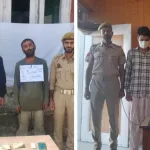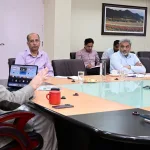Srinagar, July 12: The long-awaited dream of a proper school building for the children of Hathlanga village, near the zero line in Uri area of north Kashmir’s Baramulla district, has suffered yet another setback. The land generously donated by local residents, meant to end a two-decade-long struggle, has been rejected by engineers who cited its location on the banks of a river as “unsuitable for construction.”
For nearly 20 years, students in Hathlanga have been attending classes in a temporary community hall built by the Army after the original Government Boys Middle School was destroyed in the 2005 earthquake. With only one teacher managing around 40 students and no permanent infrastructure, the village’s children have endured minimal educational support.
“We gave our own land because the government kept saying there was none,” said Abdul Majeed Dar, a senior villager. “Now they say the land isn’t good enough. How long will our children have to wait for what every other child takes for granted?” He added that officials first claimed land was unavailable, and now they claim the donated land is close to a river.
“We gave our own land because the government kept saying there was none,” said Abdul Majeed Dar, a senior villager. “Now they even say that land isn’t good enough. How long will our children have to wait for something every other child takes for granted?” He said that earlier, the officials were saying land is not available and when local villagers provided the land, now they are coming up with another excuse that “land is close to the river.”
Javaid Ahmed Banday, Planning Officer in the Education Department, explained that engineers did not recommend the site due to its proximity to the river. “We have prepared a fresh proposal and sent it to the Rural Development Department and SamagraShiksha officials. We are hopeful it will be approved this time,” he said.
Villagers, however, insist the Education Department is reluctant to build the school. “I don’t know why officials are giving excuses. We donated one kanal of land, not just a piece. There is no river nearby,” said TalibHussain, a resident of Hathlanga. “We even have documentary evidence to prove this.”
Despite their disappointment, the villagers remain determined. “If the government wanted to solve this problem, it would have been done so many years ago,” said Tanveer Ahmad, another resident. “We are being told to wait, but generations are passing by. Our children are losing their future while files move from one table to another.”
The setback has reignited frustration among the community, which had finally seen hope when the donation was made. Parents say the psychological toll on children is growing, with many reluctant to attend school in its current condition.
“Many kids say they feel ashamed going to school in that hall. It’s not even a classroom, it’s a storage shed with no proper facilities,” said Ghulam Hassan. “The Education Department’s dilly-dallying tactics show a lack of seriousness on an issue that concerns our children’s future.”
Local education officials say they are committed to finding an alternative site and securing funds, but for the people of Hathlanga, assurances are no longer enough. In a region already grappling with challenges including natural disasters, Hathlanga’s children are paying the price of neglect. Their classroom of hope remains just that—a hope still waiting to be built.








